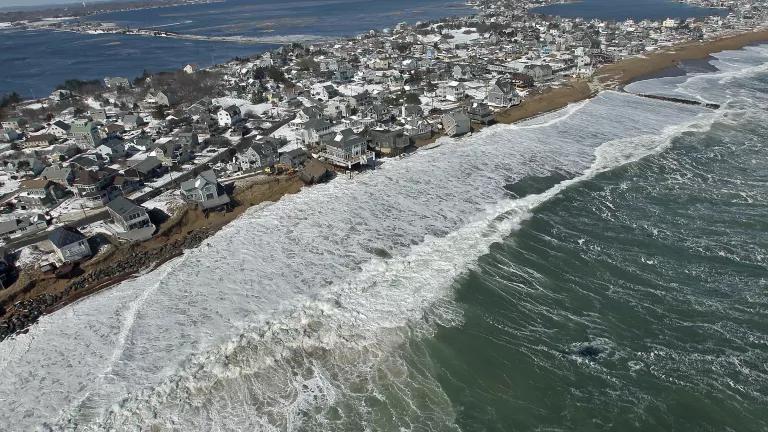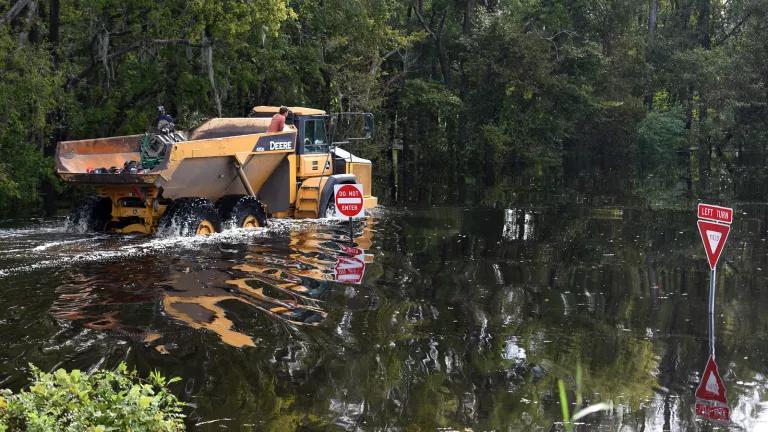Inaction on Climate Change Will Leave Us Lost at Sea
New projections suggest sea level rise could exceed 6.5 feet by 2100. But we can halt that tide by stopping runaway carbon pollution.

Waves pound against the shore of Plum Island in Massachusetts, the day after a winter storm.
David L. Ryan/The Boston Globe via Getty Images
Just in time for beach season, a new study warns that global sea level could rise by as much as six and a half feet by 2100, swamping coastal communities and displacing nearly 200 million people worldwide, unless we roll back the tide of climate change.
That dire projection, roughly double the maximum sea level rise projected just six years ago by the United Nations’ climate body, reflects the judgment of 22 U.S. and European experts in the field. In peer-reviewed findings published this week in the Proceedings of the National Academy of Sciences, they said ocean waters could expand more, and glaciers and ice sheets could melt faster, than previous analysis envisioned.
“We find it plausible” that sea level rise could exceed two meters—or about 6.5 feet—by 2100, the authors wrote. “A SLR [sea level rise] of this magnitude,” they added, ”would clearly have profound consequences for humanity.”
To say the least.
Two meters of sea level rise, the authors wrote, would flood some 691,000 square miles of cropland and other property worldwide—enough to cover the states of Texas, California, Montana, and Colorado combined—and drive some 187 million people from their homes.

Children play in floodwaters in the village of Eita in Tarawa, Kiribati. The people of Kiribati are under pressure to relocate due to sea level rise.
Jonas Gratzer/LightRocket via Getty Images
That’s what could be in store under what the authors call a “business as usual” scenario, in which the world fails to cut the carbon pollution that’s driving the climate crisis. Rising seas are one more reason we can’t afford to let that happen.
Over the past 25 years, global sea level has been rising by about an inch every eight years—or about a foot per century. That’s faster than at any other time in at least 2,000 years, and the pace of the rise is accelerating.
The U.S. National Climate Assessment released last November projected between one and four feet of sea level rise this century, putting railways, ports, and major cities like New Orleans, Miami, Charleston, and Virginia Beach at risk of being swamped.
Two feet of sea level rise would put more than 300,000 U.S. coastal homes currently worth some $118 billion at risk of what scientists call “chronic inundation.” That’s when flooding from rains or high tides becomes so frequent—twice per month, on average—that it disrupts routine activities like getting to school or work. Runaway carbon pollution, though, could cause three times that much sea level rise. Here’s why.
Carbon dioxide in the atmosphere traps heat, warming the earth. Chiefly by burning oil, coal, and natural gas, we’ve increased the concentration of carbon dioxide in the earth’s atmosphere by about 45 percent in little more than a century. As a consequence, the planet has warmed about 0.9 degrees Celsius, or 1.6 degrees Fahrenheit, and it continues to warm at the rate of about 1.7 ℃ per century. The result: Glaciers and ice sheets are melting, adding huge stores of water to the world’s oceans, while seawater expands as it, too, warms.
We can put the brakes on global warming by moving now to shift away from fossil fuels to cleaner, smarter ways to power our future. If we act swiftly and deliberately to cut carbon pollution, we can hold global warming to 1.5 ℃, or 2.7 ℉.
If we do that, the U.N. climate body estimates, we could hold global sea level rise to two and a half feet or less. If we fail to take action, though, numerous estimates suggest we could see global temperatures rising by some 5 ℃, or 9 ℉, by 2100. That would trigger sea level rise closer to four feet and, as the new study suggests, possibly as much as six and a half feet.
Under either scenario, the world we know would never be the same. We owe our children better than that.
The coming of summer reminds us anew of the stakes in the climate fight. We have to protect our families, communities, and country from the growing dangers and rising costs of this mounting crisis before it’s too late.
It’s time to heed the growing calls for action to speed a just and equitable transition to 100 percent clean energy, thriving communities, and healthy ecosystems as quickly as possible—starting now.



